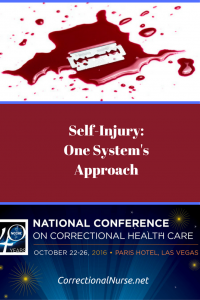Robert D. Canning, Ph.D., CCHP, is Sr. Psychologist Specialist, Quality Management Program, Statewide Mental Health Program for California Correctional Health Care Services. This post is based on his session “Self-injury: Public Health Surveillance for Quality Improvement” taking place at the 2016 National Conference on Correctional Health Care in Las Vegas, October 22-26, 2016.
 Self-injury is a growing concern in correctional health care practice. Self-injury (also called self-harm) is behavior that is self-directed and deliberately results in injury or the potential for injury to oneself. The Quality Management Program of the Statewide Mental Health Program for the California Correctional Health Care Services (CCHCS) has been systematically counting and classifying self-harm events in California prisons for about 2 1/2 years. Over that time there have been over 5,000 self-injury events; indicating that the rate of self-harm for this prison population at 2.3%. While this is low for a prison population, one systematic review found over 20% of prisoners self-harm at some time during incarceration, this is still a high number of incidents that need addressed.
Self-injury is a growing concern in correctional health care practice. Self-injury (also called self-harm) is behavior that is self-directed and deliberately results in injury or the potential for injury to oneself. The Quality Management Program of the Statewide Mental Health Program for the California Correctional Health Care Services (CCHCS) has been systematically counting and classifying self-harm events in California prisons for about 2 1/2 years. Over that time there have been over 5,000 self-injury events; indicating that the rate of self-harm for this prison population at 2.3%. While this is low for a prison population, one systematic review found over 20% of prisoners self-harm at some time during incarceration, this is still a high number of incidents that need addressed.
Published numbers of non-suicidal self-injury (NSSI) are higher among those in solitary confinement, youth, and females. In the CCHCS study, overall self-injury for men was 2.0% and for women 7.3%. Sixty-one percent of self-harm incidents were not suicidal in nature and involved little medical injury.
Interesting findings from the CCHCS study included a better understanding off the magnitude of costs associated with self-harm, particularly those incidents that require more significant medical intervention; particularly hospital treatment. Of the self-harm events counted in the past two years, almost one-quarter of them (1,263) have resulted in outside hospital stays, with a range of one to 124 days. Seventy-one percent of those have been for one day or less – typically an emergency department visit with return to the prison within hours.
CCHCS self-harm surveillance is a part of their suicide prevention program that has been around for two decades. They have found that a population-based approach is best in assessing and managing this condition.
Results of the quality initiative are currently locally-based with predominantly individual prison facility projects. For example, CCHCS is in the early stages of establishing a specialized treatment unit in one prison that will deliver Dialectical Behavior Therapy, an evidenced-based treatment for suicidal and self-harming individuals.
In addition, the CCHCS medical informatics group has been working to develop an “early warning system” for suicide attempts using machine learning algorithms. They are currently preparing a multi-year grant proposal to the American Foundation for Suicide Prevention to refine the system and make it clinically useful. This project has promise to reduce rates of suicide and self-harm in CDCR and elsewhere.
Do you have patients that self-harm? Share your experience in the comments section of this post.
This post is part of a series discussing topics addressed during sessions of the 2016 National Conference on Correctional Health Care. All posts in this series can be found HERE.
Laurie says
This works for those people who hate to bother me until their asthma is so out of control or the guy with retinal detachment who waited till after hours. All now get seen every so often for a well check. That little bit of time has helped in prevention.
Carol Chiocchi says
We have 2 inmates in the hospital right now that have swallowed razor blades. It happens often enough., very frustrating and difficult to prevent.
Lorry Schoenly says
Good point, Laurie!
Lorry Schoenly says
Yikes! I can’t imagine a situation where I would be willing to swallow a razor blade, Carol. There has got to be a lot of psychic pain, stress, or fear involved, don’t you think?
Angela says
All the time, last year I responded to an emergency when the EOP jumped off the top tier…
BLLE Fx & he admitted he wanted to take his life, sure got him into DSH w/the quickness!
Lorry Schoenly says
Those top tier railings are dangerous. Security needs to look into some form of wire netting to prevent jumps.